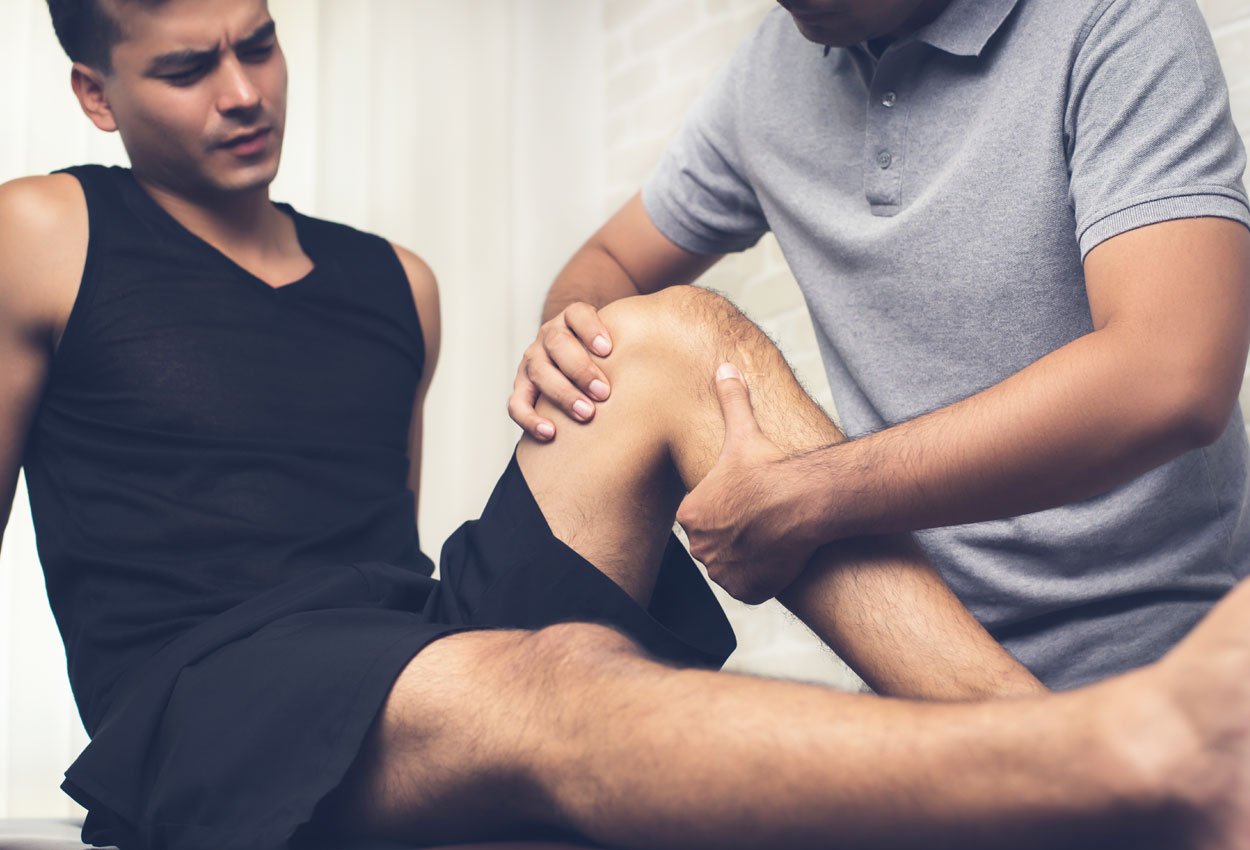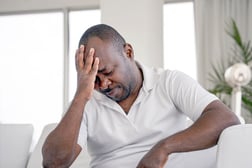
In almost every decade of life, one may find the need for rehabilitation of one kind or another. Physical Medicine and Rehabilitation is a medical specialty that helps people regain body functions they lost due to a medical condition or injury.
As people age, there may be an increased need for therapy to help with strength, balance, or mobility. This may occur after a fall, joint replacement surgery, a stroke, or other health challenges. However, the need for physical rehabilitation is not always age-related.
Rehabilitation can help those that have been in a motor vehicle accident with serious physical or neurological trauma, a sports injury, amputation, chronic pain management, and, most recently, to recover and build strength after having COVID-19.
A physical and emotional toll on the patient
Physical Medicine and Rehabilitation is often conducted as a team approach and includes many job titles such as Physiatrists, Physical Therapists, Occupational Therapists, and Speech Therapists. No matter the title, the goal is the same—to help the patient regain a level of independence.
 Rehabilitation most often takes place either in a specialized hospital setting (acute care, surgical, or rehabilitation), an outpatient facility, or the home. Wherever it occurs, rehabilitation is not easy. Rehabilitation creates stress on both the body and the mind which most often leads to anxiousness and pain.
Rehabilitation most often takes place either in a specialized hospital setting (acute care, surgical, or rehabilitation), an outpatient facility, or the home. Wherever it occurs, rehabilitation is not easy. Rehabilitation creates stress on both the body and the mind which most often leads to anxiousness and pain.
Patients going through physical rehabilitation often worry about their care plan and the hard work ahead of them. The patient may also be concerned that life will never be the same. Additionally, they may stress over unforeseen medical bills. These worries and concerns often make the patient very anxious.
Anxiousness can cause sleeplessness, and that lack of sleep can cause even more anxiousness, a cycle that can often lead to cancelled appointments. These cancellations can alter patients’ care plans and ultimately impede their rehabilitation success, creating a constant struggle for patients and their rehabilitation care team.
Perception of pain can adversely affect progress in physical therapy
Adding to this increased level of anxiousness is the potential pain factor and the patient’s fear of that pain. According to the International Association for the Study of Pain (IASP), pain “is an unpleasant sensory and emotional experience...”
 The American Physical Therapy Association (APTA) shares that pain “may be the result of actual physical damage or the perceived thought of it, which people experience as real.” With rehabilitation, there are some patients that can experience pain which can also be confused with soreness from the work being done to strengthen the body and range of motion. With this perceived fear of pain, it can add to the cycle of anxiousness, sleeplessness, and even more rehabilitation challenges.
The American Physical Therapy Association (APTA) shares that pain “may be the result of actual physical damage or the perceived thought of it, which people experience as real.” With rehabilitation, there are some patients that can experience pain which can also be confused with soreness from the work being done to strengthen the body and range of motion. With this perceived fear of pain, it can add to the cycle of anxiousness, sleeplessness, and even more rehabilitation challenges.
The move away from pharmaceuticals
While both anxiousness and pain can be treated using pharmaceuticals, their use often presents challenges for the patient. Many of these medications can cause drowsiness, which can lead to falling. Falls, particularly in compromised patients, can cause serious and sometimes fatal injuries.
 According to the article, "Medications that Increase your Risk of Falling" (Harvard Health Publishing, November 2021), both anti-anxiety medications and narcotics (opioids) suppress the central nervous system, reducing alertness which may lead to a fall. When taken together, the risk of falling increases.
According to the article, "Medications that Increase your Risk of Falling" (Harvard Health Publishing, November 2021), both anti-anxiety medications and narcotics (opioids) suppress the central nervous system, reducing alertness which may lead to a fall. When taken together, the risk of falling increases.
This danger, coupled with the opioid epidemic, is moving clinicians and pain treatment plans to use over-the-counter analgesics such as Acetaminophen or Ibuprofen whenever possible, to decrease the use of narcotics.
In an effort to reduce the need for opioid medications, The Joint Commission updated their Pain Assessment and Management Standards for all hospitals in January 2018. These new standards required that all Joint Commission accredited hospitals offer a non-pharmacological option for pain.
Growing adoption of clinical aromatherapy in physical medicine and rehabilitation
With this new standard, many hospitals began to explore the use of the complementary, holistic approach of aromatherapy.
The National Association for Holistic Aromatherapy (NAHA) defines aromatherapy as “using natural plant extracts, such as essential oils… in a variety of ways to heal the body, mind and spirit”. Inhalation and topical application are two of the most common ways that aromatherapy is used. One such method is Elequil aromatabs®.
Encompass Health is the largest owner and operator of rehabilitation centers in the U.S with 146 hospitals, 251 home health locations, and 96 hospice locations operating in 42 states and Puerto Rico. On their corporate blog, Encompass Health promotes the use of aromatherapy.
In their blog post "Easing Anxiety with Aromatherapy," the author shares how using Elequil aromatabs® in a rehabilitation setting has helped their patients relax and sleep better.
The author of another article, "Aromatherapy for Pain Management," shares how aromatherapy helped her amputee patient cope with and overcome extreme pain and tremendous anxiousness during her physical rehabilitation stay:
 “A patient with a recent above-knee amputation was admitted to our hospital for inpatient rehabilitation. She had high levels of pain from the amputation, as well as increased anxiety, which frequently led to her crying and having shortness of breath before her occupational and physical therapy sessions. She was afraid to move her leg due to the anticipated pain and began to miss therapy sessions.
“A patient with a recent above-knee amputation was admitted to our hospital for inpatient rehabilitation. She had high levels of pain from the amputation, as well as increased anxiety, which frequently led to her crying and having shortness of breath before her occupational and physical therapy sessions. She was afraid to move her leg due to the anticipated pain and began to miss therapy sessions.
"An aromatherapy product was suggested to help her cope with her pain, anxiety, and fear. After two days of using the aromatherapy product, the patient was participating in a full therapy day. She was able to decrease her pain medications and had a more positive outlook overall on her rehabilitation and potential success. The patient became an advocate for aromatherapy by the end of her stay. Printed patient education resources were provided to the patient to continue this success after her discharge home.”
About Elequil aromatabs
Elequil aromatabs® have been used by over 2,200 hospital and healthcare facilities for the benefit of both patients and staff. Made from 100% pure, unadulterated essential oils, Elequil aromatabs contain no pesticides or synthetics and are uniquely designed to be worn on the patient’s gown or clothing and offer a minimum or maximum amount of aroma.
Elequil aromatabs are available in four simple essential oil blends: Lavender, Lavender-Sandalwood, Lavender-Peppermint, and Orange-Peppermint.
 The three Elequil aromatabs that contain lavender promote relaxation during pain and help comfort and calm anxiousness. These beautiful aromas are made from the proprietary blend of Lavender and Lavandin Grosso. With the addition of Sandalwood, Elequil aromatabs Lavender-Sandalwood can last up to 24 hours of continued comfort and calming.
The three Elequil aromatabs that contain lavender promote relaxation during pain and help comfort and calm anxiousness. These beautiful aromas are made from the proprietary blend of Lavender and Lavandin Grosso. With the addition of Sandalwood, Elequil aromatabs Lavender-Sandalwood can last up to 24 hours of continued comfort and calming.
Adding peppermint to the Elequil aromatabs Lavender-Peppermint gives the extra benefit of soothing queasiness. All three of the Elequil aromatabs lavender blends are the perfect adjunct tool for rehabilitation to help with anxiousness and pain.
The fourth Elequil aromatabs is a blend of orange and peppermint which naturally uplifts and may help provide a mental boost, which is often essential during rehabilitation, and can help to soothe queasiness.
To request complimentary samples or learn more about the benefits of using Elequil aromatabs® in Physical Medicine and Rehabilitation, contact Beekley Medical at 800-233-5539 or info@beekley.com.

Laura Smith
Senior Clinical Product Specialist—Elequil aromatabs® | Certified Aromatherapist
